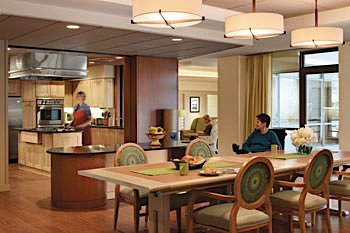 The Leonard Florence Center for Living in Chelsea, Mass., is part of what’s known as the Green House project, founded by geriatrician Dr. Bill Thomas as an alternative to traditional nursing homes. Each apartment includes a large, centrally located kitchen and dining room designed to be the heart of the home. Residents often take part in meal planning and preparation.
The Leonard Florence Center for Living in Chelsea, Mass., is part of what’s known as the Green House project, founded by geriatrician Dr. Bill Thomas as an alternative to traditional nursing homes. Each apartment includes a large, centrally located kitchen and dining room designed to be the heart of the home. Residents often take part in meal planning and preparation.
The Center, in a working-class neighborhood on the outskirts of Boston is technically a nursing facility — a place most people hope they can avoid. But for Rhoda Klein, age 79, this five-story urban complex feels like home.
There’s a calm and comfortable atmosphere in Klein’s apartment, which she’s decorated with her own furnishings. Outside Klein’s door is a common area with an open kitchen, a fireplace and a long dining room table where other residents in her suite often hang out to talk or eat. The residents interact with their caregivers, assigned four at a time to the suite, with the ease of old friends. There aren’t many rules or schedules to follow.
“I decide every morning what I want to do that day,” Klein says. “I can share group meals if I want to. Or play bingo and just have a snack. If I get hungry later, someone will make me a meal.”
Klein’s nursing home lifestyle is also notable for what it isn’t. There’s no long gray linoleum corridors with doors that open onto shared rooms with nothing but a curtain between the beds. No beeping monitors or carts full of soiled linens and no patients in wheelchairs parked in the hallways. Few rules govern when, what and where residents can eat.
Massachusetts played a big role in making the $37 million center in Chelsea possible. And it’s encouraging other nursing homes across the state to provide similar settings and more personalized services, whether in new buildings or traditional ones. In fact, nearly every state now is promoting what policymakers and advocates simply call “culture change” — creating environments for the aged and disabled that feel more home-like than institutional.
But it isn’t easy to reverse habits and procedures or undo the architecture of institutions that have been around since the 1960s, when the enactment of Medicare and Medicaid spawned a major expansion of the nursing home industry.
For millions of Americans — and state governments, too — the question of what kind of care nursing homes should provide will be impossible to avoid in the coming years. By 2020, the number of people aged 85 years and older — those most likely to need long-term care — will reach 15.4 million, up from 4.3 million in 2000, according to the U.S. Census Bureau. For states, nursing homes and other long-term care services represent more than 30 percent of a more than $320 billion annual Medicaid bill.
The reason nursing homes have traditionally had an institutional feel to them is that most were designed in the mode of hospitals. That mentality extended to the physical space, leading to a standard two-wing design with a nurse’s station in the middle — a floor plan known in the industry as the “double-loaded corridor.” It also extended to the state regulations and rules governing everyday life in nursing homes. These tended to favor considerations for safety and medical care over concern for residents’ quality of life.
 As a result, frail elders in nursing homes have suffered from the “three plagues of boredom, helplessness and loneliness,” says Dr. Bill Thomas, a geriatric physician and a leader in the culture change movement. A self-described nursing home “abolitionist,” Thomas would like to see old-style nursing homes eliminated altogether.
As a result, frail elders in nursing homes have suffered from the “three plagues of boredom, helplessness and loneliness,” says Dr. Bill Thomas, a geriatric physician and a leader in the culture change movement. A self-described nursing home “abolitionist,” Thomas would like to see old-style nursing homes eliminated altogether.
That won’t happen anytime soon. The nursing home industry is not growing; it’s shrinking. Despite an increase in the number of frail elders who need care, more are opting to remain at home or enter an assisted living facility where they can live more independently.
According to the Centers for Disease Control and Prevention, there are some 16,000 nursing homes in the United States, averaging about 30 years old with an occupancy rate of 86 percent. Most of them were designed the old way, and many will need renovation or replacement in the next decade.
In their place, Thomas wants to see more small cottages or apartments like the one Klein lives in at the Leonard Florence Center — designed for 10 to 12 residents with skilled health care workers who give individual attention to each person. Thomas’ design has been replicated in 50 such facilities in 13 states, built with the support of the Robert Wood Johnson Foundation and NCB Capital Impact, a nonprofit community development organization. Dozens of other small nursing facilities have been built across the country with the same goals in mind, gaining support from private donations, and in some cases, direct state and federal grants.
States are adopting new attitudes toward regulation so that facilities can create more home-like settings and give elders more privacy and control over their environment. Arkansas, for example, recently changed a rule that prevented residents from using air fresheners in their rooms. The state also got rid of a regulation that prevented nursing facilities from serving hot coffee from a cart early in the morning instead of making residents wait for a cold cup on their breakfast trays.
It’s a lot of little things, says Carol Shockley, Arkansas director of long-term care. But they make a big difference in people’s daily lives. Residents especially appreciate having more control over what they eat. “If a resident just hates broccoli,” Shockely says, “a nursing home ought to be able to take it off his plate.”
Workforce training is another important piece, because few health care workers have had experience with what is known in the culture change movement as “person-centered” care. Instead, they’ve typically performed just one of the services needed to support a frail elder or disabled adult.
Massachusetts spent more than $200 million over an eight-year period to train and mentor health care workers in this new method of care, although that program has been cut back since the recession. Georgia, Kansas, Michigan, North Carolina, Oregon and Vermont made similar investments.
States have found other ways to push culture change in nursing homes. Rhode Island has developed a survey that grades facilities based on whether they look more like an institution or a home, whether they allow residents flexibility in their sleeping and eating schedules and how well they’ve reduced annoying noises. Colorado pioneered a point system that bumps up Medicaid reimbursement rates for facilities that provide more home-like settings. Oklahoma has taken similar measures. Arkansas offers a higher Medicaid reimbursement rate for so-called “home-style” nursing homes.
With all the budget cutting states have had to do in recent years, and will continue to have to do, it may be difficult for states to make a lot of progress in this area. Still, some are trying.
Orinially published by Stateline.org



















